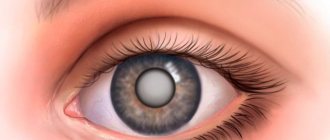Microsurgery involves removing the clouded lens and replacing it with an artificial one. As a rule, such treatment allows you to almost completely restore vision, so the choice of lenses is taken very seriously, studying which lens is best to use for cataracts.
In this article
- What is the lens of the eye?
- When should you get a new lens?
- Properties of artificial lens
- In what cases should lens replacement surgery not be performed?
- Types of intraocular lenses
- Replacing the eye lens for cataracts: which lenses are better
What is the lens of the eye?
The lens is part of the eye's optical system. This is a kind of lens that refracts light rays and focuses the image on the retina. For clear vision, the lens must be as transparent as possible.
Also important is its elasticity: in order to see clearly both near and far, the accommodation mechanism is activated. It involves the work of muscles that bend the lens, allowing the eye to focus on objects at different distances. The elasticity of the lens tends to decrease with age, which is why natural accommodation becomes weaker. In such cases, it is worth considering replacing the lens.
Why do you have to change the lens for myopia and astigmatism?
Both types of ametropia greatly complicate a person’s life, impose certain restrictions on him in professional activities, and interfere with his ability to play sports. These pathologies constantly progress if left untreated. For initial and moderate degrees of myopia and astigmatism, the patient is prescribed to wear glasses or contact lenses.
However, correction means are not means of treatment; they only correct a refractive error, that is, they allow a person to see well, despite the presence of visual pathology. Myopia and astigmatism can be treated with laser surgery or lens replacement surgery. The latter treatment method is usually used for high degrees of myopia and astigmatism.
When should you get a new lens?
An artificial lens (intraocular lens) is installed instead of a natural lens in cases of loss of its properties.
The most common cause is clouding of the lens of the eye due to cataracts, caused by the natural aging processes of the body in older people. The intraocular lens is placed inside the eye and performs the functions inherent in the natural lens, providing the necessary visual characteristics.
Properties of artificial lens
In terms of their properties, intraocular lenses are as close as possible to the natural lens. They have a yellow filter that provides UV protection to the retina. Typically, they are designed with a component that helps prevent spherical distortion and provide clear contrast vision during the day and evening, which is especially important for drivers and people in other professions where it is necessary to see well in any light level.
An artificial lens consists of an optical part, which ensures that it performs its main functions, and haptic elements (fixators), due to which the lens is securely fixed in the eye.
The optimal site for implantation of an intraocular lens is the capsular bag of the lens. If such installation is not possible, the lens can be placed in other parts of the eye, for example on the iris, anterior or posterior chamber (outside the capsular bag).
The first artificial lenses were made from the inelastic plastic polymethyl methacrylate. Nowadays, the most popular are lenses made of elastic materials, which allow the lens to be folded using injectors and surgery to be performed through small incisions.
It is also important to choose the optimal shape of the lens before surgery: a person’s ability to see objects in focus depends on this. Unlike a natural one, an artificial product is not capable of accommodation, so it is important to choose a good lens.
Another important point is the color of the lens. With age, the optical element acquires a yellow color, due to which it can filter out a large amount of light in the blue part of the spectrum. Reducing the amount of blue light leads to deterioration of twilight vision.
In what cases should lens replacement surgery not be performed?
Like any other surgical intervention, replacing the lens with an artificial one has some contraindications: general and specific, characteristic of this method of vision restoration. Before deciding on surgery, many factors need to be taken into account, including an analysis of the general state of health and, in particular, the visual system.
Contraindications to lens replacement surgery include:
- Infections and inflammations of the eyes: the decision about surgical intervention can be revised based on the results of antibacterial and anti-inflammatory therapy.
- Decompensated glaucoma: surgery is possible only after normalization of intraocular pressure (an exception is the type of glaucoma when intraocular pressure increases as a result of cataracts).
- Decompensation of the general condition during heart attack, stroke, etc. In this case, the decision to perform an operation is made solely based on the results of treatment of these diseases.
- Pregnancy and breastfeeding: replacement of the eye lens only in cases of urgent need.
Recommendations for the patient during the rehabilitation period
The recommendations below are general in nature and developed for the general population of patients. In cases of a non-standard postoperative period, the doctor must offer an individually selected treatment regimen, as well as a schedule of routine examinations of the patient. It is better to clarify the previously received recommendations at each doctor’s examination!
- Mode. After replacing the lens of the eye with IOL implantation, it is not necessary to remain in bed or semi-bed rest. However, it is worth following some instructions related to sleep patterns: sleeping on the side of the operated eye and on the stomach is not recommended for the first few days after the intervention.
- Hygiene. Washing your face and hair during the rehabilitation period should be extremely careful. It is necessary to be careful not to get soap or water into the operated eye. To wash your hair, it is better to choose a position with your head tilted back. In a situation where water gets into the operated eye, it needs to be washed with an aqueous solution of 0.02% furatsilin or an aqueous solution of 0.25% chloramphenicol.
- An appointment prescribed by your doctor should not be missed!
- Bandage. On the first postoperative day, it is recommended to wear a sterile bandage over the eye, which will protect it from bright light and dust particles scattered in the air. The bandage is made independently from two-layer gauze, after which it is attached to the forehead with an adhesive plaster, like a curtain.
- Eye drops. In order to speed up the healing of the surgical wound and prevent infection, which complicates the postoperative period, the use of certain eye drops is recommended. As a rule, these are several medicines: with disinfectant properties (Floxal, Ciprofloxacin, Tobrex), anti-inflammatory effects (Naklof, Indocollir), or combined drops (Maxitrol, Tobradex). Such drugs are usually prescribed to be used in a decreasing pattern: in the first week - four times a day, in the second week - three times a day, in the third week - twice a day, the entire fourth week - once every day. In the future, complete withdrawal of drugs will follow. These recommendations should be clarified at each scheduled examination by a specialist!
Types of intraocular lenses
The following types of artificial lenses are distinguished:
- “Rigid” - have an inflexible, permanent shape. Their implantation requires large surgical incisions, followed by suturing the patient and a long rehabilitation period.
- “Soft” - made of elastic synthetic polymers. They are implanted through a self-sealing micro-incision approximately 2.5 mm long. They can be placed inside the eye when folded, they unfold themselves and are securely fixed. Soft lenses do not require sutures.
There are also six main types of lenses for cataracts:
- monoblock;
- with yellow filter;
- aspherical;
- toric;
- multifocal;
- accommodating.
The aspherical shape of the lenses means that when light hits any point, the refractive power will be the same: both in the center and at the edges of the lens. This is important in the dark, when the pupil dilates.
Among the advantages of such soft lenses is minimal “glare” from light sources in the dark and twilight. So, they are comfortable when driving a car when there is light from oncoming cars. In addition, such lenses have good color rendering and contrast.
Spherical artificial lenses for the eyes refract light with different strengths, which creates a light scattering effect, contributes to the appearance of glare and flare, as a result of which the quality of vision deteriorates.
The next type of lens is toric. If during his life the patient suffered from astigmatism (an irregular shape of the cornea that distorts the image), he wore special glasses with cylinders. Modern artificial eye lenses have learned to cope with this problem. If a person with astigmatism is given a regular lens, the astigmatism will remain the same and he will have to resort to cylindrical glasses again. It is better to install toric IOLs: the necessary cylinder is already built into them, so the person will receive normal vision, without image distortion.
It is worth noting that this type of artificial lens for cataracts is selected for each patient individually; before the operation, complex calculations are made to determine which lens is best to install for cataracts. This is due to their higher cost, however, according to reviews, toric lenses give better results.
Multifocal lenses for the eyes have several optical foci, due to which they can provide maximum visual acuity both near and at long distances. Thanks to this, patients can forget about glasses. When installing a standard (monofocal) lens, the patient must use glasses for visual activity at close range.
How much to wait?
The phrase has already become common: “Cataracts are not a fruit, you don’t need to wait for them to mature.”
But doctors in clinics still tell patients that cataracts are either incipient or still “immature” and send them to wait. No need to wait!
There is nothing to wait - it won’t get better, the cataract, increasing, will force the surgeon to use more ultrasonic energy, which in turn will negatively affect the structures surrounding the lens - the cornea, choroid, “maturation” will weaken the ligamentous apparatus, cause changes in the lens capsule, increase intraocular pressure. The indication for cataract surgery is decreased vision caused by its presence. And visual acuity is no longer important here. There are, for example, types of posterior capsular cataracts, when it is necessary to operate with vision of 1.0, since the quality of vision suffers.
Sometimes, if you wait an extra couple of months, you will have to abandon phacoemulsification in favor of extracapsular cataract extraction (ECE). Wait a little longer, and the capsule will also become unusable, and only intracapsular extraction (IEC) will be possible. Naturally, the “older” the operation is historically, the more difficult and longer the healing process is, which leads to secondary complications. A common problem with these “manual” types of surgeries is surgically induced astigmatism. The smaller the incision and the more accurately it is located, the better the patient will see after surgery. The larger the incision, the worse the refractive picture will be after rehabilitation. By the way, a little over 15 years ago I was working on the technology of cataract removal through a 1 mm incision, using a bimanual technique and implanting an interesting ThinOptix lens model through the same 1 mm.
A decade ago, there was a technological idea to destroy the lens through a hole less than 1 mm formed in the anterior capsule of the lens by rotating microblades. But for now, removal after 1.7-1.8 mm is minimal and optimal.











